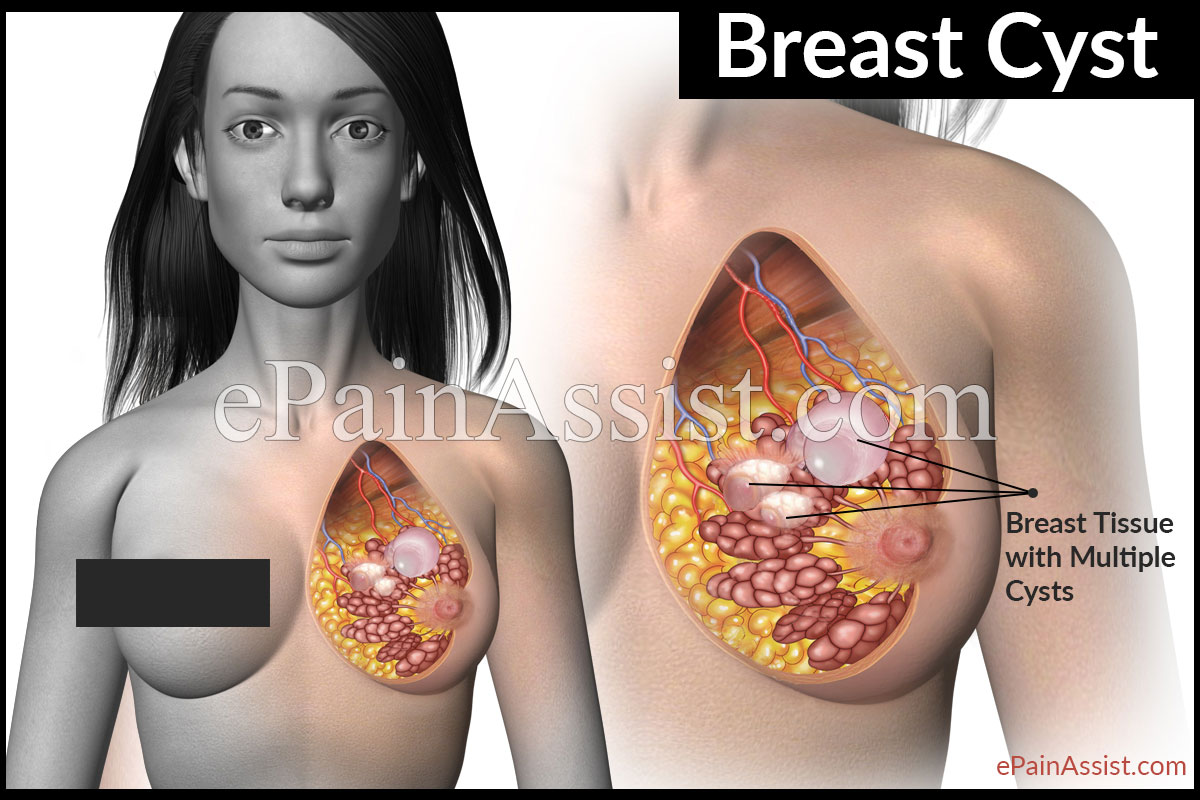What Is Breast Cyst?
Breast Cysts are benign fluid-filled sacs which develop in the breasts. These cysts may be a solitary cyst or there may be quite a number of cysts present. There are usually round with regular edges. These cysts may resemble a water balloon. Breast Cysts are usually benign and do not require any specific treatment until they become painful and abnormally large in which case aspiration of the cyst or an excision of the cyst may be required. Breast Cysts are common in females between the ages of 35 and 50 and go away once the woman reaches menopause.

What Causes Breast Cyst?
The breasts contain lobes of tissue which are then subdivided into small lobules, which are responsible for producing milk when the female is pregnant which is used for breast feeding the infant. There are small ducts in the lobules which carry the milk to the nipples. There are other supportive tissues giving the breast the shape it has. Breast Cysts tend to develop due to overgrowth of glands and connective tissues which block the milk ducts, which then are filled with fluid and become wide. There are two types of cysts, microcyst and macrocyst. Microcyst is a type of cyst which tends to be too small to be visible and can only be recognized on radiographic images. A macrocyst is a type of cyst which is quite large and is generally painful as it puts pressure on the adjoining breast tissues. There is no known cause as to why the glands tend to have overgrowth causing formation of cysts but some studies suggest that excess production of estrogen can cause the glands to swell and result in formation of cysts.
What Are The Symptoms Of Breast Cyst?
Some of the symptoms of Breast Cysts are:
- Smooth movable round lump in the breast which have regular edges
- These lumps may be found in one breast or both the breasts
- Pain and tenderness in the breasts
- Pain and tenderness increases with onset of menstrual periods
- Decrease in pain and tenderness after the menstrual periods.
How Is Breast Cyst Diagnosed?
As soon as a lump in the breast is identified the treating physician will immediately order screening studies of the breasts. The physician will also ask about the duration of the tenderness and will conduct a physical examination looking for areas of pain and tenderness.
Breast Exam: During a breast examination, as stated the physician will look at the areas of the pain and tenderness and then may order imaging studies or aspiration of the lump to confirmly diagnose a breast cyst.
Breast Ultrasound: An ultrasound of the breast may also be performed so as to find out whether the lump is filled with fluid or is it a solid lump. If it is confirmed that the cyst is filled with fluid then the diagnosis of a breast cyst is confirmed. Depending on the type of lump a biopsy may be performed to rule out breast cancer.
Fine-needle Aspiration: This is by far the most preferred test for confirming a Breast Cyst. In this procedure, a needle is inserted in the lump and the fluid is aspirated under local anesthetic and sent for laboratory for analysis. This totally confirms the diagnosis of a breast cyst. If clear fluid is aspirated out and the lump goes away then no treatment or any further testing is required.
How Is Breast Cyst Treated?
In case the cyst is very small and only visible on radiologic studies then no treatment is required and the cyst goes away on its own. This is specifically true if the female has not attained menopause. The most preferred treatment for a Breast Cyst is an aspiration of the cyst which has been explained above in the diagnosis section. In case if the cyst is quite large and needle aspiration does not resolve then an excision of the cyst using a surgical approach is recommended. Breast Cysts are quite common and tend to recur frequently and frequent aspiration may be required
Using hormones: Regulating menstrual cycles can help in reducing the recurrence of Breast Cysts. This can be done by using hormones or OCPs, but these needs to be done under strict supervision of the gynecologist since there are many inherent side effects and complications with hormone and OCP use.
What Are Some Do’s And Don’ts For Breast Cyst?
The following measures may help in reducing discomfort due to Breast Cysts:
- Wearing a well fitted bra which gives good support to the breasts and provide relief from discomfort and pain
- Reducing caffeine intake also goes a long way in reducing the symptoms of Breast Cysts.
- Salt restriction has also been shown to be effective in symptom relief due to Breast Cysts.
- Over the counter pain medications and NSAIDs like Tylenol and ibuprofen can also be used to reduce pain and discomfort due to Breast Cysts.
Also Read:
- Fibrocystic Breast Disease: Causes, Symptoms, Diagnosis, Treatment, Diet
- What Can Cause Shooting Pain in Breast?
- Causes of Breast Secretion or Nipple Discharge & its Treatment, Prognosis, Complications
- Is There a Link Between Caffeine Intake & Breasts Lumps?
- What are Breast Lumps: 9 Causes of Breast Lumps, its Treatment & Prevention
